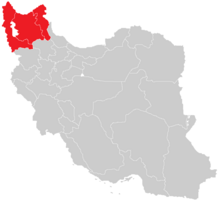
| Part of a series on |
| Azerbaijanis |
|---|
| Culture |
| Traditional areas of settlement |
| Diaspora |
| Religion |
| Language |
| Persecution |
37°36′N 47°00′E / 37.6°N 47.0°E Azerbaijan or Azarbaijan (Persian/Azerbaijani: آذربایجان, romanized: Āzarbāyjān, Persian pronunciation: [ɒːzæɾbɒːjˈdʒɒːn], Azerbaijani pronunciation: [ɑːzæɾbɑjˈdʒɑn]), also known as Iranian Azerbaijan,[1] is a historical region in northwestern Iran that borders Iraq and Turkey to the west and Armenia, Azerbaijan, and the Azerbaijani exclave of the Nakhchivan Autonomous Republic to the north.
Iranian Azerbaijan includes three northwestern Iranian provinces: West Azerbaijan, East Azerbaijan and Ardabil.[2][3] Some authors also include Zanjan in this list, some in a geographical sense,[4] others only culturally (due to the predominance of the Azeri Turkic population there).[5] The region is mostly populated by Azerbaijanis, with minority populations of Kurds, Armenians, Tats, Talysh, Assyrians and Persians.
Iranian Azerbaijan is the land originally and historically called Azerbaijan; the Azerbaijani-populated Republic of Azerbaijan appropriated the name of the neighbouring Azerbaijani-populated region in Iran during the 20th century.[6][7][8] Historic Azerbaijan was called Atropatene in antiquity and Aturpatakan (Adurbadagan) in the pre-Islamic Middle Ages. Some people refer to Iranian Azerbaijan as South (or Southern) Azerbaijan and the Republic of Azerbaijan as Northern Azerbaijan,[9] although others believe that these terms are irredentist and politically motivated.[10][11][12]
Following military defeats at the hands of the Russian Empire, Qajar Persia ceded all of its territories in the North Caucasus and Transcaucasia to Russia via the Treaty of Gulistan of 1813 and the Treaty of Turkmenchay of 1828.[13] The territories south of the Aras River, which comprised the region historically known as Azerbaijan, became the new north-west frontier of the Persian Empire and later Iran.[14] The territories north of the Aras River, which were not known by the name Azerbaijan at the time of their capture by Russia, were absorbed into the Russian Empire, renamed the Azerbaijan Democratic Republic during the country's short-lived independence from 1918 to 1920,[15] incorporated into the Soviet Union as the Azerbaijan Soviet Socialist Republic, and finally became the independent Republic of Azerbaijan when the Soviet Union dissolved.
- ^ James Minahan. "Miniature Empires", Published by Greenwood Publishing Group, 1998.
- ^ "Azerbaijan: Region, Iran". Encyclopedia Britannica. Archived from the original on 2020-04-20. Retrieved 2019-10-06.
- ^ The Encyclopaedia of Islam, Volume XI (Brill Publishers, Leiden, 2002). Article: "Zandjan", page 446:
The mediaeval geographers mostly placed Zandjan in Djibal province, usually linking it with Abhar [q.v] or Awhar some 80 km/50 miles to its south-east, but they usually stated that it was on the frontier with Adharbaydjan, and some authorities attributed it to Daylam or to Rayy.
- ^ Tadeusz Swietochowski; Brian C. Collins (1999). Historical Dictionary of Azerbaijan. Scarecrow Press. p. 65. ISBN 978-0-8108-3550-4. Archived from the original on 2017-04-06. Retrieved 2019-11-02.
- ^ Touraj Atabaki (4 November 2000). Azerbaijan: Ethnicity and the Struggle for Power in Iran. I.B.Tauris. pp. 8, 90 and 112. ISBN 978-1-86064-554-9. Archived from the original on 26 February 2021. Retrieved 2 November 2019.
- ^ Atabaki, Touraj (2000). Azerbaijan: Ethnicity and the Struggle for Power in Iran. I.B.Tauris. p. 25. ISBN 9781860645549.
- ^ Dekmejian, R. Hrair; Simonian, Hovann H. (2003). Troubled Waters: The Geopolitics of the Caspian Region. I.B. Tauris. p. 60. ISBN 978-1860649226. Archived from the original on 2021-01-19. Retrieved 2020-11-08.
Until 1918, when the Musavat regime decided to name the newly independent state Azerbaijan, this designation had been used exclusively to identify the Iranian province of Azerbaijan.
- ^ Rezvani, Babak (2014). Ethno-territorial conflict and coexistence in the caucasus, Central Asia and Fereydan: academisch proefschrift. Amsterdam: Amsterdam University Press. p. 356. ISBN 978-9048519286.
The region to the north of the river Araxes was not called Azerbaijan prior to 1918, unlike the region in northwestern Iran that has been called since so long ago.
- ^ Brown, Cameron S. (December 2002). "Observations from Azerbaijan". Middle East Review of International Affairs. 6 (4). Archived from the original on 23 February 2003. Retrieved 2020-02-02.
- ^ Michael P. Croissant, "The Armenia-Azerbaijan Conflict: Causes and Implications", Praeger/Greenwood, 1998. excerpt from pg 61: "During the Soviet-era historical revisionism and myth-building intended to denounce imperialism, the notion of a "northern" and "southern" Azerbaijan was created and propagated throughout USSR. It was charged that the "two Azerbaijanis" once united were separated artificially by a conspiracy between imperial Russia and Iran".
- ^ Ethnic Conflict and International Security, Edited by Michael E. Brown, Princeton University Press, 1993
- ^ Bert G. Fragner, ‘Soviet Nationalism’: An Ideological Legacy to the Independent Republics of Central Asia’ in Van Schendel, Willem (Editor). Identity Politics in Central Asia and the Muslim World: Nationalism, Ethnicity and Labour in the Twentieth Century. London, GBR: I. B. Tauris & Company, Limited, 2001. Excerpt from pg 24: "Under Soviet auspices and in accordance with Soviet nationalism, historical Azerbaijan proper was reinterpreted as 'Southern Azerbaijan', with demands for liberation and, eventually, for 're'-unification with Northern (Soviet) Azerbaijan – a breathtaking manipulation. No need to point to concrete Soviet political activities in this direction, as in 1945–46 etc. The really interesting point is that in the independent former Soviet republics this typically Soviet ideological pattern has long outlasted the Soviet Union."
- ^ Swietochowski, Tadeusz (1995). Russia and Azerbaijan: A Borderland in Transition. Columbia University Press. pp. 69, 133. ISBN 978-0-231-07068-3. Archived from the original on 2015-07-13. Retrieved 2020-11-08.
- ^ Timothy C. Dowling Russia at War: From the Mongol Conquest to Afghanistan, Chechnya, and Beyond Archived 2016-09-03 at the Wayback Machine pp 728–729 ABC-CLIO, 2 dec. 2014 ISBN 1598849484
- ^ Siavash Lornejad, Ali Doostzadeh. ON THE MODERN POLITICIZATION OF THE PERSIAN POET NEZAMI GANJAVI Archived 2021-08-28 at the Wayback Machine CCIS, 2012 ISBN 978-9993069744 p 10